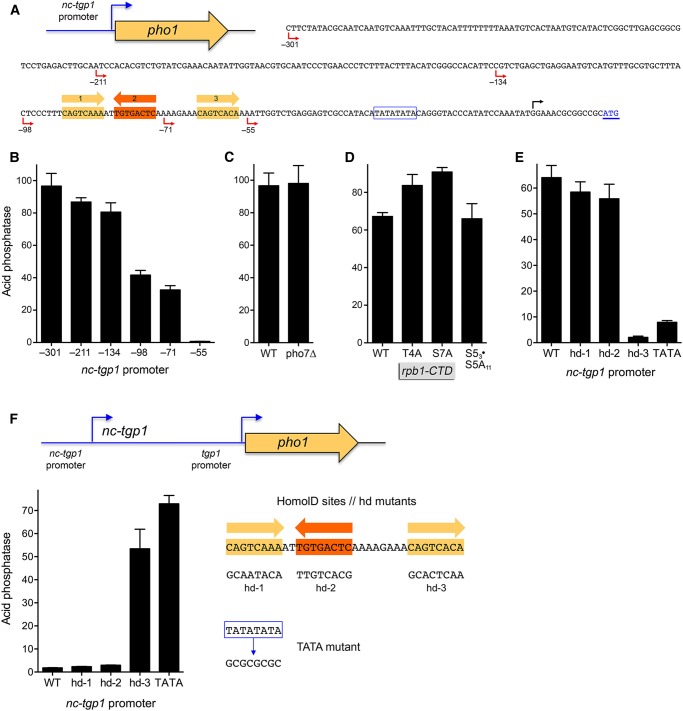FIGURE 2.
HomolD and TATA boxes are essential for nc-tgp1 promoter activity and regulation of tgp1. (A) Plasmid reporter of nc-tgp1 promoter activity. The pho1 ORF (beginning at the underlined ATG translation initiation codon in blue font) was fused downstream from a fragment of genomic DNA containing the nc-tgp1 transcription start site (indicated by the black arrow above the DNA sequence) and 301 nt of 5′ flanking nc-tgp1 DNA (presumed to include the nc-tgp1 promoter). Serial truncations of the upstream margin of the 5′ flanking nc-tgp1 DNA were made at positions −211, −134, −98, −71, and −55 (indicated by red arrows below the DNA sequence) relative to the nc-tgp1 transcription start site. A putative TATA element is outlined by a blue box. Three putative HomolD elements are shaded in gold (forward orientation) or orange (reverse orientation). (B) Acid phosphatase activity of pho1Δ cells bearing the indicated nc-tgp1 promoter-driven pho1 reporter plasmids. (C) Acid phosphatase activity of pho1Δ pho7+ (WT) and pho1Δ pho7Δ cells bearing the −301 nc-tgp1 promoter-driven pho1 plasmid. (D) Acid phosphatase activity of pho1Δ rpb1-CTD strains bearing the −301 nc-tgp1–pho1 plasmid. (E,F) The indicated mutated versions of individual HomolD sites (hd-1, hd-2, and hd-3) and the TATA box of the nc-tgp1 promoter (shown at right in panel F) were introduced into the −301 nc-tgp1•pho1 reporter and phosphate-replete pho1Δ cells bearing the indicated nc-tgp1•pho1 reporter plasmids were assayed for acid phosphatase activity (panel E). (F) The HomolD and the TATA box mutations of the nc-tgp1 promoter were introduced into the nc-tgp1–tgp1•pho1 reporter plasmid (shown at the top of the panel). Phosphate-replete pho1Δ cells bearing the indicated reporter plasmids were assayed for acid phosphatase activity.

